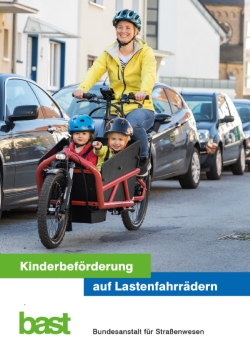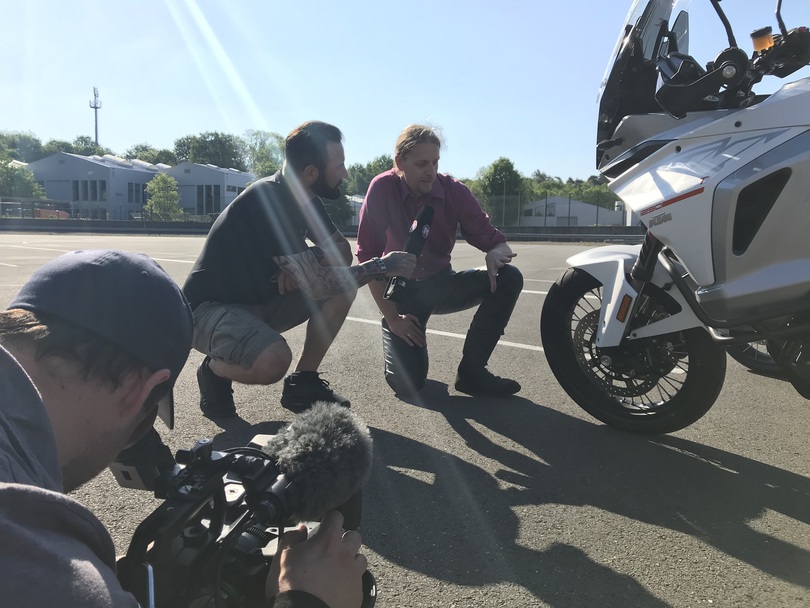
Source: Deutsche Verkehrswacht e.V.
Using bicycles, e-scooters or any two-wheel motor vehicle is popular, environmentally friendly and, usually, it does not require a search for a parking space. Cycling in particular has seen a real boom in recent years, be it with or without electrical assistance.
The use of two-wheeled vehicles is associated with an increased likelihood of being injured, as, in the case of an accident, the user can only be protected against injuries to a limited extent.
In 2023, a total of 141,649 motorcycle, e-scooter and bicycle users were injured in accidents, 1,017 of which fatally. This means that 38 percent of all casualties and 36 percent of all road fatalities were users of motorcycles, bicycles or e-scooters. In 2023, a total of 497 people were killed in road traffic while riding a motorcycle with a licence plate, 446 were killed while riding a bicycle (of which 190 were riding a pedelec), 53 a motorcycle with an insurance plate and 21 a small electric vehicle such as e-scooter.
The Ministry is supporting and funding initiatives and activities to enhance road safety for riders of two-wheel vehicles, be it bicycles, pedelecs, electric scooters or motorcycles.
Transport of children on cargo bikes

Source: BASt
Cycling is all the rage. Cargo bikes are also increasingly being used - be it for transporting weekly groceries or for transporting children. The Federal Highway Research Institute (BASt) has published a brochure with tips on equipping and handling cargo bikes from the first test ride to everyday use. With the focus on the transport of children, useful equipment features are mentioned to support the selection of a suitable cargo bike. In addition, motor exercises for handling a cargo bike are described, which should be completed before using the bike in traffic. The brochure “Child transport on cargo bikes” can be ordered from BASt or downloaded from the website.
Learn how to cycle: not a problem with the right exercises and patience
In the free brochures of the German Accident Prevention Organization (Deutsche Verkehrswacht, DVW) the path towards safe cycling is illustrated: from children being prepared with balance bikes and scooters, learning the motor skills involved in cycling and the use of bicycles in a protected road environment to adolescents taking part in moving traffic. The explanations are brief and compact and can be implemented directly.
The following DVW brochures can be downloaded from this website free of charge (all Brochures in German):
- Learn how to cycle - riding on wheels for pre-school children,
- Cycling for children between 7 to 10 years
- Cycling for children from 10 years.
Safe cycling programme (“FahrRad, … aber sicher!”)

Source: Deutsche Verkehrswacht e.V.
There are many questions relating to all aspects of cycling. Answers to these questions are given at the safe cycling programme days (in German: Verkehrssicherheitstage FahrRad, … aber sicher!) of the DVW. The variety of topics is very diverse, ranging from the recommendation to wear a cycle helmet, useful motor skills exercises for adults and children, a graphic illustration of the dangers of the "blind spot”, safe equipment of bicycles and the issue of drunk cycling. Volunteers of the DVW provide advice to visitors in a sometimes playful and sometimes serious way. In practical exercises on the pedelec course or the electric scooter course, visitors are encouraged to train their motor skills as well as consider possible consequences of risky behaviour. The events are held within the framework of sport cycling events and bicycle fairs as well as at town fairs and cycle rallies. More information on the safe cycling programme (“FahrRad, … aber sicher!”) can be found here (in German).
"Turn your head to see cyclists": the dooring campaign

Source: Deutscher Verkehrssicherheitsrat e.V.
A dooring accident. What does it actually mean? It means accidents involving a vehicle door that is suddenly opened, causing a cyclist to collide with the door and being injured. In these ‘dooring accidents’, it is too late for the cyclist to brake or swerve to avoid the vehicle. They often suffer serious head or leg injuries. More than every tenth car driver (13 percent) rarely or never consider that cyclists could be approaching from behind when they open the door to leave the vehicle. Many underestimate the danger and therefore risk causing cyclists to fall off their bikes. Since mid-2019, the “Turn your head to see cyclists” campaign has been raising awareness, particularly among vehicle occupants, of the danger of dooring accidents. The message is clear: whoever turns their head and looks over their shoulder when leaving a vehicle will avoid serious collisions. More information as well as the “Turn your head to see cyclists” campaign’s clip can be found here (in German).
Have fun also watching the following short videos of the campaign on YouTube:
The dangerous door: music (Video in German).
The dangerous door: multitasking (Video in German).
The dangerous door: arguing (Video in German).
Safely riding a pedelec
Every year, more pedelecs are sold. Bicycles with electric pedal assistance up to 25 km/h can extend the rider's personal range by far; driving up steep hills is also not a problem. However, cycling safely on a pedelec has to be learned. The Ministry has drawn up a leaflet about the safe use of pedelecs. Besides the strong recommendation to only use pedelecs with a cycle helmet, the leaflet contains valuable advice on exercises to prepare yourself for riding a pedelec and tips for a safe participation in motorised road traffic. The differences between a pedelec, e-bike and S-Pedelec are also described.
With the support of the Ministry, the German Road Safety Council illustrates the use of a pedelec in a clip.
To the leaflet on pedelec safety (in German).
To the clip: “Turn your head to see cyclists” (in German).
“Motorcycling? Sure, but stay safe”. A journey through social media

Source: Industrieverband Motorrad e.V.
By addressing the right target group on social media such as Instagram, Youtube and Facebook, the Motorcycle Industry Association (Industrieverband Motorrad, IVM), with the support of the Ministry, is reaching out to motorcyclists and drivers of motor scooters. Targeting the online user behaviour of riders of two-wheel motor vehicles, not only is safety-related content included but there is also an active exchange with the community. We are therefore not talking about the target group but rather with them.
The collaboration with the “Motorcycling? Sure, but stay safe” VivaLaMoped online magazine is very successful. The number of fans of this page is even higher than the number of fans of well-known motorcycle magazines. Content on safe driving and vehicle safety is illustrated by means of GIFS (moving graphics), internet memes (internet in-jokes) or cinemagraphs (still photographs in which a movement repeats itself). The range of offers is completed by short films and expert discussions - often in line with the season. More information on the “Motorcycling? Sure, but stay safe” VivaLaMoped online magazine (in German).
“Scooting without risks” - the first nationwide campaign on e-scooters
A representative survey by the Forsa institute for market research commissioned by the DVR has shown that many users of e-scooters are not aware of the applicable rules for using these vehicles. Every second person asked did not know which blood alcohol limit applied to the use of e-scooters. With its motto “Scooting without risks”, the DVR, with support of the Ministry, is raising awareness of the dangers of rule infringements when riding an e-scooter.
The most important rules can be seen, among other things, on stickers and signs on the handlebars of the vehicles of rental companies, which are directly in the field of vision of the driver. There are also warnings concerning driving under the influence of alcohol on coasters and free postcards from Edgar Cards. Information on the “Scooting without risks” campaign and the survey (in German).